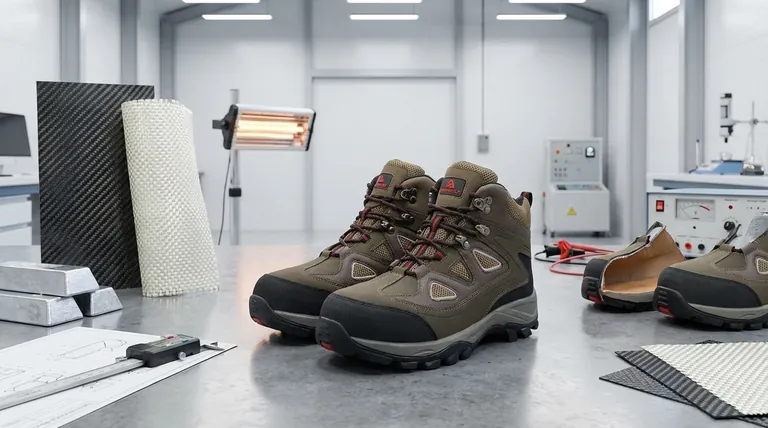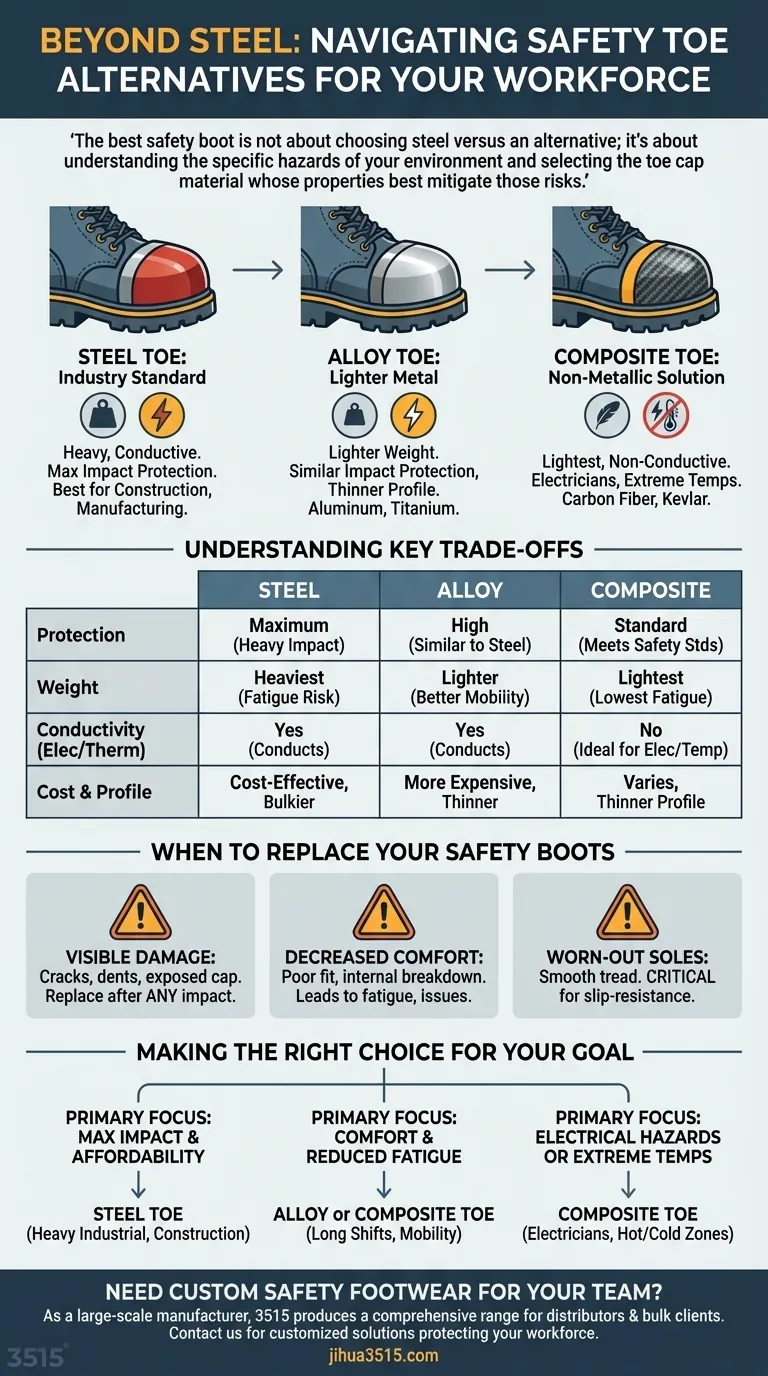The two most common alternatives to traditional steel-toe boots are alloy-toe and composite-toe boots. Alloy toes use lightweight metals like aluminum or titanium to offer protection similar to steel in a less bulky cap, while composite toes use non-metallic materials like carbon fiber, fiberglass, or Kevlar to provide protection without conducting electricity or temperature.
The best safety boot is not about choosing steel versus an alternative; it's about understanding the specific hazards of your environment and selecting the toe cap material whose properties—weight, conductivity, and impact resistance—best mitigate those risks.

Deconstructing the Safety Toe Options
To make an informed decision, it's essential to understand the distinct characteristics of each type of protective footwear. They are all designed to meet specific safety standards but achieve this with different materials and benefits.
Steel Toe: The Industry Standard
Steel has long been the benchmark for safety footwear. It's used in demanding fields like construction and heavy manufacturing for its proven ability to protect against extreme impact and compression from heavy objects.
While highly effective, steel's primary drawbacks are its weight, which can cause fatigue over long shifts, and its thermal and electrical conductivity.
Alloy Toe: Lighter Metal Protection
Alloy-toe caps are crafted from lightweight metals such as aluminum and titanium. They provide a similar level of impact and compression resistance as steel but in a thinner, lighter package.
This reduction in weight makes them significantly more comfortable for workers who are constantly on the move. The main trade-off is often a higher price point compared to traditional steel-toe boots.
Composite Toe: The Non-Metallic Solution
Composite toes are made from materials like carbon fiber, fiberglass, plastic, or Kevlar. Their key advantage is that they contain no metal, making them the lightest option available.
Because they don't conduct electricity, heat, or cold, composite-toe boots are the ideal choice for electricians or anyone working in environments with extreme temperatures. While they meet all safety standards, they may offer slightly less protection against the absolute highest impact forces compared to their metal counterparts.
Understanding the Key Trade-offs
Choosing the right boot requires balancing protection, comfort, and environmental factors. No single type is universally superior; the best choice depends entirely on your specific job requirements.
Protection vs. Weight
Steel offers maximum protection but is the heaviest. Alloy provides comparable protection at a reduced weight. Composite is the lightest of all, meeting safety standards while significantly reducing foot fatigue.
Electrical and Thermal Hazards
This is a critical differentiator. Both steel and alloy caps conduct electricity and temperature, making them unsuitable for certain electrical work and uncomfortable in extreme hot or cold climates. Composite toes do not conduct, making them the only safe and practical choice for these specific conditions.
Cost and Profile
Steel-toe boots are typically the most cost-effective option. Alloy boots tend to be more expensive due to the material costs. Composite boots vary in price but can also be more expensive than steel. Because alloy and composite caps can be thinner, they sometimes allow for a less bulky, more streamlined boot design.
When to Replace Your Safety Boots
Regardless of the material, a safety boot is only effective if its protective features are intact. You should replace your boots immediately if you notice any of these signs.
Visible Damage
Any visible cracks, dents, or exposure of the toe cap itself means the boot's integrity is compromised. After any significant impact incident, a boot should be replaced even if damage isn't obvious.
Decreased Comfort or Support
If the boot no longer fits well or the internal structure has broken down, it can create new hazards. A lack of support can lead to fatigue and musculoskeletal issues.
Worn-Out Soles
Once the tread on the sole is worn smooth, the boot loses its critical slip-resistance. This is a common but often overlooked reason for replacement that is crucial for preventing falls.
Making the Right Choice for Your Goal
Your daily tasks and work environment should be the ultimate guide for your decision.
- If your primary focus is maximum impact resistance and affordability: A traditional steel-toe boot remains an excellent and cost-effective choice for heavy industrial or construction work.
- If your primary focus is comfort and reduced fatigue during long shifts: An alloy-toe or composite-toe boot will provide certified protection while being noticeably lighter than steel.
- If your primary focus is working around electrical hazards or in extreme temperatures: A composite-toe boot is the only appropriate choice to ensure your safety and comfort.
Ultimately, selecting the correct protective footwear is a critical decision based on a clear-eyed assessment of your specific workplace risks.
Summary Table:
| Safety Toe Type | Key Materials | Primary Benefits | Ideal For |
|---|---|---|---|
| Steel Toe | Steel | Maximum impact resistance, cost-effective | Heavy manufacturing, construction |
| Alloy Toe | Aluminum, Titanium | Lightweight, similar protection to steel | Workers needing mobility and comfort |
| Composite Toe | Carbon fiber, Kevlar | Non-conductive, lightest option | Electricians, extreme temperatures |
Need Custom Safety Footwear for Your Team?
As a large-scale manufacturer, 3515 produces a comprehensive range of safety boots and shoes for distributors, brand owners, and bulk clients. Whether you need steel, alloy, or composite toe protection, we can manufacture the perfect footwear to meet your specific safety standards and comfort requirements.
Contact us today to discuss your bulk order and get a customized solution that protects your workforce.
Visual Guide

Related Products
- Safety Footwear Wholesale Manufacturer for Custom OEM/ODM Production
- Premium KPU Injection Athletic Style Safety Shoes
- Wholesale Safety Footwear Manufacturer for Bulk & Custom OEM Orders
- Premium Flame-Retardant Waterproof Safety Boots and Shoes
- Premium Insulated Safety Boots and Shoes for Wholesale & Bulk Orders
People Also Ask
- How do safety shoes contribute to cost savings for companies? A Strategic Investment in Risk and Cost Management
- Is it normal to wear shoes in the house? A Guide to Hygiene, Comfort & Culture
- What do heavy duty boots do? Protect Your Feet in Demanding Work Environments
- What are OSHA approved shoes? Understanding the Correct Standards for Workplace Safety
- Do snake bite boots work? Your Ultimate Guide to Effective Snake Bite Protection



















